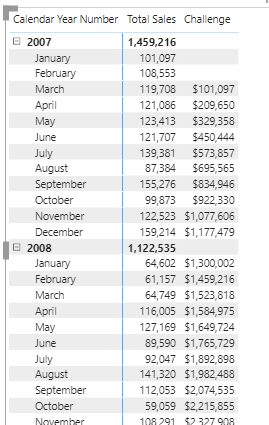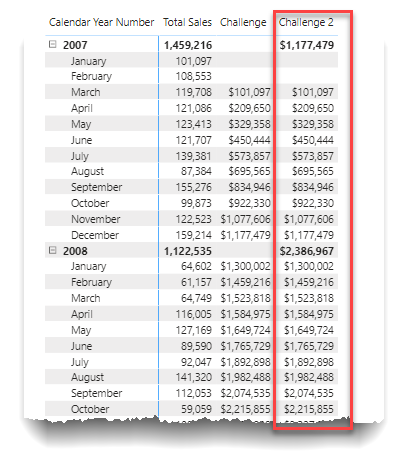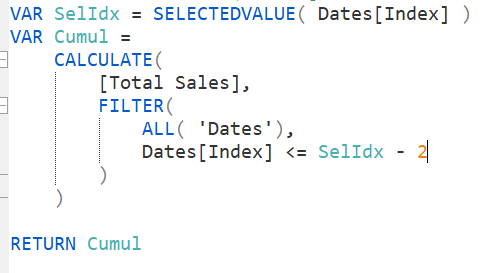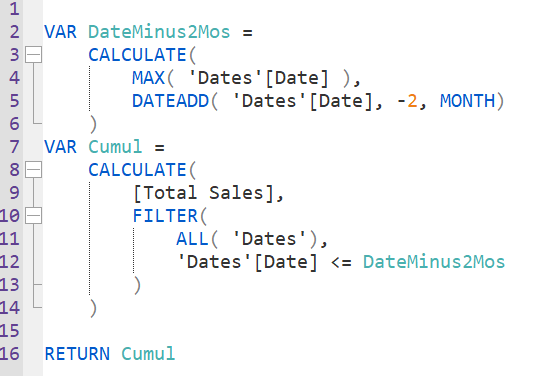Here is your data:
DAX Problem 1.pbix (132.7 KB)
This is what you need to accomplish (Challenge Measure):
Caveat - You can’t use IF/SWITCH function.
Here is your data:
DAX Problem 1.pbix (132.7 KB)
This is what you need to accomplish (Challenge Measure):
Caveat - You can’t use IF/SWITCH function.

Got the main measure, but are we not allowed to use IF/SWITCH even for fixing matrix totals?

Nice one 
Pro tip, mark your date table as a date table LOL
Challenge =
CALCULATE(
CALCULATE( [Total Sales],
FILTER(
ALL( Dates[Date] ),
Dates[Date] <= MAX( Dates[Date] )
)
), DATEADD( Dates[Date], -2, MONTH )
)
@BrianJ Nope, that’s the fun part. 
@Melissa Awesome!
Did you have to think for a while about where to evaluate MAX? I was working on this late at night and I had MAX outside of CALCULATE and had to think for some time why it wasn’t working!
Thanks @AntrikshSharma
No because it has to be in context of the visual…
 I spend more time examining the date table than writing the measure, to be honest…
I spend more time examining the date table than writing the measure, to be honest…
Ah 


For the win! (explanation hidden under summary below)

My initial strategy focused on development of a DAX-based index that would cross years, that I could back up two periods in the cumulative calculation. This worked like a champ, except that Power BI threw up a big

for the totals and substotals. Here was the Index measure I developed:
and then the Challenge measure that used that Index:

When the totals fell over, I realized that the index was just effectively backing up the dates by 2 months, so I tried DATEADD to do the same thing, figuring that perhaps the transition to the index and back again was screwing up the totals. If I’d been allowed to use IF(HASONEVALUE) or IF(HASONEFILTER), I could have fixed the first Challenge measure, but the Grinch stole those along with my Date Offsets…
So, here’s the Challenge 2 measure using DATEADD instead of the DAX index.

I can’t say I understand exactly why this doesn’t screw up the totals also, but it doesn’t so I’ll take that as a win.
Very cool problem. Thanks for posting this - really enjoyed working on it!
Thanks for your new initiative it’s really fun to learn with this. Here is my solution
Challenge =
VAR TimeTravel =
CALCULATE ( MAX ( Dates[Date] ), PARALLELPERIOD( Dates[Date], -2, MONTH ) )
VAR Result =
CALCULATE (
[Total Sales],
FILTER ( ALLSELECTED ( Dates ), Dates[Date] <= TimeTravel )
)
RETURN
Result
Run the filter context first to get the Running total and then shifting that with 2 months.
Thanks
Mukesh

Anymore takers?
May be it didn’t spread to wider audience @BrianJ and @Melissa has ability to spread it wider/faster  .
.
Thanks
Mukesh
F Pastor =
CALCULATE(
CALCULATE (
[Total Sales],
FILTER (
ALL ( Dates[Date] ),
‘Dates’[Date] <= MAX ( Dates[Date] )
)
),
DATEADD( Dates[Date], -2, MONTH)
)
@FPastor You might want to hide the DAX you posted by using the spoiler effect.
If you highlight your DAX and then go to the cog in the message bar and use the spoiler button/effect
Thanks David, good to know for the next one…
cog, is this a new DAX measure  where do i find it…
where do i find it…
Don’t worry Federico cog is part of the message bar when you are typing a message on the forum. I wasn’t very clear.
Thank David - you’re the best 
Here are some variations I could come up with, mostly logic is same but you can see how much you can modify a simple code: DAX Problem 1.pbix (143.2 KB)
M1 =
CALCULATE (
VAR MaxDate = MAX ( Dates[Date] )
RETURN
CALCULATE (
[Total Sales],
Dates[Date] <= MaxDate,
REMOVEFILTERS ( Dates )
),
DATEADD ( Dates[Date], -2, MONTH )
)
.
M2 =
CALCULATE (
VAR MaxDate =
MAX ( Dates[Date] )
VAR DatesAndSales =
ADDCOLUMNS ( ALL ( Dates[Date] ), "@Sales", [Total Sales] )
VAR Result =
FILTER ( DatesAndSales, Dates[Date] <= MaxDate )
RETURN
SUMX ( Result, [@Sales] ),
DATEADD ( Dates[Date], -2, MONTH )
)
.
M3 =
VAR StartDate =
CALCULATE ( MAX ( Dates[Date] ), DATEADD ( Dates[Date], -2, MONTH ) )
VAR Result =
CALCULATETABLE (
ADDCOLUMNS (
VALUES ( Dates[Date] ),
"@Sales", [Total Sales]
),
REMOVEFILTERS ( Dates )
)
RETURN
SUMX (
FILTER ( Result, Dates[Date] <= StartDate ),
[@Sales]
)
.
M4 =
VAR StartDate =
CALCULATE ( MAX ( Dates[Date] ), DATEADD ( Dates[Date], -2, MONTH ) )
VAR Result =
CALCULATE (
[Total Sales],
CALCULATETABLE ( ALL ( Dates ) ),
Dates[Date] <= StartDate
)
RETURN
Result
.
M5 =
VAR StartDate =
CALCULATE ( MAX ( Dates[Date] ), DATEADD ( Dates[Date], -2, MONTH ) )
VAR DatesTemp =
CALCULATETABLE (
VALUES ( Dates[Date] ),
REMOVEFILTERS ( Dates )
)
RETURN
CALCULATE (
[Total Sales],
DatesTemp,
Dates[Date] <= StartDate
)